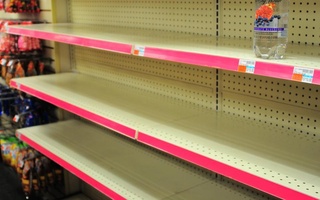Hurricane Sandy brought with her not only devastating floods and forceful winds, but also a flurry of speculation about global warming and its relation to the unusual scale of the storm.
Marked by 80-110 mile per hour winds and 13 foot high flood tides, the post-tropical cyclone was one of the largest storms to afflict the East Coast in years. Although any given storm cannot be attributed to such a broad phenomenon as global warming, research has shown that warmer waters due to climate change contributed to the storm’s intensity. In particular, warmer temperatures can give hurricanes fuel to grow larger and travel farther.
“I know a lot of scientists are reluctant to make the connection, because I know there’s not a lot of direct evidence, but it’s very likely, and it’s definitely not making things better,” said Leverett House Eco-Representative Courtland A. Kelly ’13.
Another factor induced by global warming that may have contributed to the scale of the storm is the shifting of the North Atlantic Oscillation (NAO), which accounts for the difference in atmospheric pressure between the South Arctic and North Atlantic regions. As Arctic waters grow increasingly warm, the NAO trends negative during the autumn and winter, according to recent research by Charles Greene and colleagues at Cornell University. One of these shifts caused a jet stream to sweep across the U.S., Canada, and the Atlantic, which coincided with the arrival of Hurricane Sandy.
Although there are factors that amplified the behavior of Hurricane Sandy, many experts caution that a single storm cannot be directly linked to global warming so simply.
Although there are factors that amplified the behavior of Hurricane Sandy, many experts caution that a single storm cannot be directly linked to global warming so simply.
Others express their concern that the focus of Hurricane Sandy should not be on its potential relationship with global warming, but rather on improving the country’s infrastructure so that we will be better prepared for future storms and prevent extensive destruction and loss of life. Sandy alone is reported to have incurred $20 billion worth in damages.
“With or without climate change, we have unusually large events. I think it’s beyond statistical capacity to link the two,” said Environmental Engineering professor John Briscoe.
“These are very complex phenomena. I would spend far less time thinking, 'Is this climate change?' I would like to see the Crimson and the students at Harvard concerned about the infrastructure; learn how to build infrastructure and finance infrastructure,” he said.
Indeed, Hurricane Sandy has opened eyes and raised concern and awareness, having prompted scholars and government officials to critically examine the nation’s infrastructural failings in the national press as well as shed light on the potential of global warming to exacerbate future meteorological events.
“I hope that Hurricane Sandy can prove to be a wake-up call and move us away from the silence seen throughout the 2012 political campaigns, and spark a broader conversation about how important climate change is and continues to be,” said Cabot House Eco-Representative Isabella A. Wechsler '13.
Read more in News
Living in a Parrot ParadiseRecommended Articles
-
Walker's "Grease" Helps an Old Favorite Run SmoothlyA story of 1950s teenagers falling in, out, and back into love may sound sentimental, but the latest production of “Grease” delves into the darker side of this romantic narrative.
-
 It Must Be 'An Act of God'
It Must Be 'An Act of God' -
Tweets of the Week: Hurricane SandyBy now you’ve probably heard of that nice young lady named Sandy. She made history on Sunday night when she caused classes to be cancelled, resulting in a near-stampede in Lamont. She even shut down schools and public transportation from here to Washington, D.C.
-
Students Assist Red Cross EffortA week after Hurricane Sandy hit the East Coast, the Harvard Red Cross kicked off a fundraiser Sunday with the goal of raising one thousand dollars for hurricane victims.
-
Harvard Lends a Helping HandWhile the efforts of those on campus may be only a small part of the larger national effort to rebuild, as the Harvard College Red Cross emphasized, no amount of help is too small to make a difference.
-
What Sandy Hath WroughtHurricane Sandy wasn’t too hard on us here in Cambridge: minimal flooding, no power loss, and, of course, no classes. But in some of the areas that were more severely affected, people had to seriously consider what was essential to their lives and what was frivolous. People in areas where power was lost went into a strange, quasi-hibernation mode.













